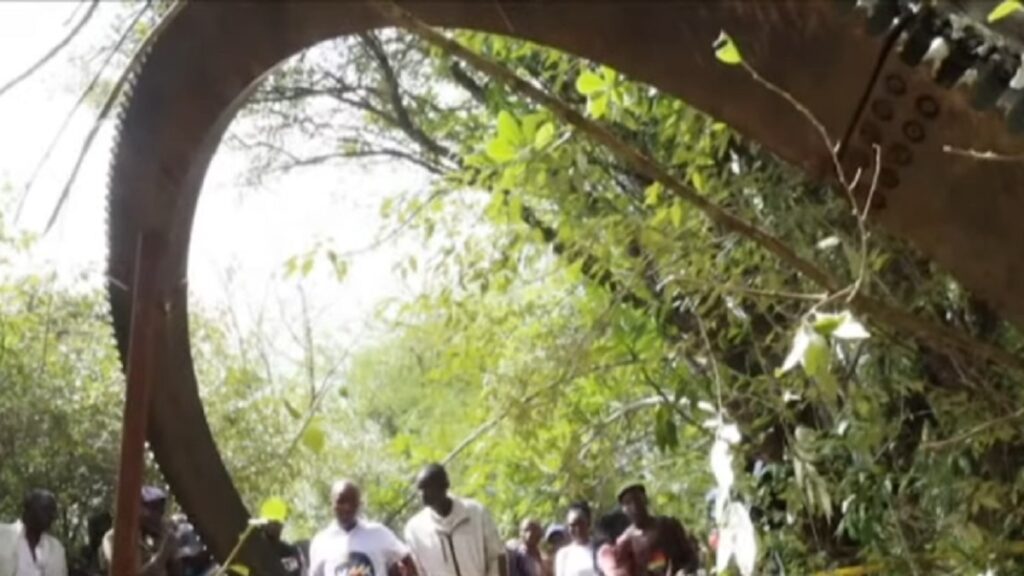In a jaw-dropping incident, the residents of a Kenyan village were left reeling when a colossal metal ring, tipping the scales at 500 kg, plummeted into a field just days before the New Year celebrations. This surreal occurrence sparked a whirlwind of speculation about its origins, with various theories emerging around the mysterious object’s descent from the sky.
An Unidentified Flying Object
On December 30, a sizeable metallic ring, measuring 2.5 meters in diameter and weighing around half a ton, crashed down onto a rural field southeast of Nairobi. Despite the lack of injuries, the shocking sight of such a significant and unfamiliar object hitting the ground prompted immediate intrigue and concern. Was it a fragment of an airplane? A remnant of a satellite? Or could it have been debris from a spacecraft not of this world?
Local authorities swiftly cordoned off the area, preventing curious onlookers from approaching the bizarre wreckage. The Kenyan Space Agency (KSA) was called to assess and retrieve the object, eventually issuing an official statement two days later that aimed to clarify the mystery.
Insights from the Space Agency
The KSA identified the object as a separation ring from a rocket, a component designed to detach during spacecraft launches. According to the KSA, this incident was an unusual occurrence. Typically, such items burn up upon re-entry into the atmosphere or land in uninhabited areas like oceans. The ring’s landing in a populated area, however, raised concerns over space safety protocols.
In alignment with international space regulations, Kenyan authorities have initiated an investigation, although the exact source of the rocket remains undetermined. Some experts speculate that the ring may have originated from a mission conducted years prior, as space debris can linger in orbit for decades before ultimately descending to Earth.
Who Claims Responsibility for Space Debris?
As investigations unfolded, questions concerning the origin of the debris persisted. The KSA issued a clarification on January 3, 2025, to dispel media reports erroneously suggesting that the Kenyan government sought compensation from India. The KSA confirmed that no such claim was made, disassociating the object from the Indian Space Research Organisation (ISRO).
This incident underscores a growing concern about space debris, which includes remnants from rocket launches and satellites. This issue has escalated into a global concern, given the heightened risk it poses to both satellites and life on Earth.
The Rising Threat of Space Debris
The event in Kenya highlights a much broader dilemma facing the world. NASA reports that millions of pieces of space debris are orbiting Earth, with over 27,000 large enough to be tracked. The Kessler syndrome—where collisions increase the amount of debris—poses a real and troubling threat to the future of space exploration. If unchecked, it could render Earth’s orbit unmanageable and severely limit future missions.
Such incidents are not isolated; in 2024, an American family lodged a lawsuit against NASA after debris from the International Space Station (ISS) struck their home in Florida. These events drive home the urgent need for effective management of space waste.
Potential Solutions on the Horizon
In response to this escalating issue, various organizations—ranging from space agencies to private enterprises—are exploring solutions. Ideas being considered include debris-cleaning satellites capable of capturing and removing hazardous waste, along with passive deorbiting systems for defunct satellites. However, deploying these technologies on a large scale presents considerable technical and financial barriers.
Despite these ongoing efforts, the Kenyan incident serves as a crucial reminder that space cannot be treated as a limitless dumping ground. While the advantages of space exploration are substantial, the environmental impact must be managed. It is imperative for the global community to adopt responsible practices to handle space debris, safeguarding both our earthly realm and the expanse beyond.
The unexpected fall of this 500-kg metal ring is merely one of many indicators that action must be taken to avert similar occurrences. By addressing this issue proactively, we can continue our journey into the cosmos without transforming our planet into a graveyard of space junk.







